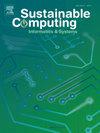Energy-efficient communication in WSNs using ABCP: An Aurora and quantum tunneling approach
IF 5.7
3区 计算机科学
Q1 COMPUTER SCIENCE, HARDWARE & ARCHITECTURE
引用次数: 0
Abstract
Cluster-based routing has been effective for facing the unique problems of Wireless Sensor Networks such as handling energy consumption and forwarding data in large, limited resource environments. Based on how the Aurora Borealis changes over time, this paper proposes the Aurora-Based Clustering Protocol which relies on virtual electrical drift and quantum tunneling to select flexible clusters and their heads. According to ABCP, a sensor node is represented by a charged particle and its virtual charge is measured by considering remaining energy and nearby data amounts. Nodes in the network are linked by streamlines created with magnetic-inspired methods and cluster heads are selected randomly using a fitness model that aims for both balance and central locations. It offers support for changing network arrangements and arranges paths so that communication is efficient wherever and whenever users move. ABCP was tested by running multiple simulations with a network of 300 nodes which reflects how a WSN might be used in real life. Against standard approaches such as LEACH, BeeCluster, iABC and PSO-based schemes, ABCP saves up to 28.7% more energy and adds at least 17.4% to the network’s lifetime under varying and densely packed node conditions.
基于ABCP的无线传感器网络节能通信:极光和量子隧道方法
基于集群的路由在面对无线传感器网络的独特问题时是有效的,例如在大型、有限的资源环境中处理能量消耗和转发数据。根据北极光随时间的变化规律,提出了基于虚拟电漂移和量子隧道的基于北极光的聚类协议,该协议可以选择柔性簇及其簇头。根据ABCP,传感器节点由带电粒子表示,通过考虑剩余能量和附近数据量来测量其虚电荷。网络中的节点通过以磁力为灵感的方法创建的流线连接起来,并且使用旨在平衡和中心位置的健身模型随机选择簇头。它支持更改网络安排和安排路径,以便无论何时何地用户移动,通信都是有效的。ABCP通过在300个节点的网络上运行多个模拟来测试,这反映了WSN在现实生活中的使用情况。与LEACH、BeeCluster、iABC和基于pso的标准方法相比,在不同和密集的节点条件下,ABCP节省了高达28.7%的能量,并至少增加了17.4%的网络寿命。
本文章由计算机程序翻译,如有差异,请以英文原文为准。
求助全文
约1分钟内获得全文
求助全文
来源期刊

Sustainable Computing-Informatics & Systems
COMPUTER SCIENCE, HARDWARE & ARCHITECTUREC-COMPUTER SCIENCE, INFORMATION SYSTEMS
CiteScore
10.70
自引率
4.40%
发文量
142
期刊介绍:
Sustainable computing is a rapidly expanding research area spanning the fields of computer science and engineering, electrical engineering as well as other engineering disciplines. The aim of Sustainable Computing: Informatics and Systems (SUSCOM) is to publish the myriad research findings related to energy-aware and thermal-aware management of computing resource. Equally important is a spectrum of related research issues such as applications of computing that can have ecological and societal impacts. SUSCOM publishes original and timely research papers and survey articles in current areas of power, energy, temperature, and environment related research areas of current importance to readers. SUSCOM has an editorial board comprising prominent researchers from around the world and selects competitively evaluated peer-reviewed papers.
 求助内容:
求助内容: 应助结果提醒方式:
应助结果提醒方式:


